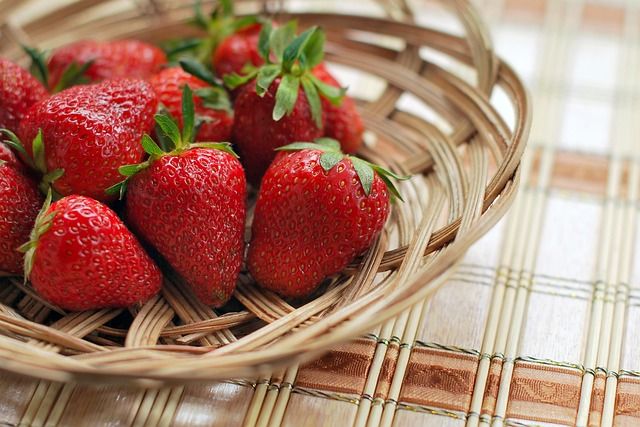
VERSIÓN ESPAÑOL:
¿Cómo va la gente de Blurt?
Les aúllo el chisme por el que seguro vienen a leer a mi cueva de meditación:
La fresa es una fruta pequeña, de color rojo brillante y sabor dulce con un toque ácido. Su superficie está cubierta de diminutas semillas doradas, y su pulpa es jugosa y aromática. Crece en plantas rastreras que pertenecen al género Fragaria, desarrollándose en climas templados y suelos bien drenados.
Es una fuente rica de vitamina C, antioxidantes y fibra, lo que la convierte en un alimento beneficioso para la salud. Se consume fresca, en mermeladas, postres, jugos y ensaladas, además de ser un ingrediente clave en la repostería. Su aroma característico es utilizado en productos cosméticos y perfumes.

Las fresas requieren cuidados específicos durante su cultivo, incluyendo una exposición adecuada al sol y riego constante sin encharcamiento. Su recolección suele realizarse a mano para evitar daños en la fruta. Son apreciadas en gastronomía por su versatilidad y su equilibrio entre dulzura y acidez.
La fresa es una fruta apta para la mayoría de las personas debido a su alto contenido en vitaminas, antioxidantes y fibra. Es ideal para niños, adultos y personas mayores, ya que fortalece el sistema inmunológico, favorece la digestión y contribuye a la salud cardiovascular. También es adecuada para quienes buscan una alimentación equilibrada, deportistas que necesitan energía natural y personas con dietas de control de peso debido a su bajo aporte calórico y efecto saciante.
Los diabéticos pueden consumirla con moderación, ya que tiene un bajo índice glucémico y ayuda a regular los niveles de azúcar en sangre. También es recomendada para personas con hipertensión por su contenido en potasio, que ayuda a equilibrar la presión arterial. Aquellos que desean mejorar la salud de su piel y cabello pueden beneficiarse de su riqueza en vitamina C y antioxidantes.
Sin embargo, quienes tienen alergia a las fresas deben evitarlas, y las personas con problemas gástricos, como gastritis o reflujo, deben moderar su consumo para evitar molestias. En casos de cálculos renales relacionados con oxalatos, es recomendable consultar a un médico antes de incorporarlas en grandes cantidades.

Rica en antioxidantes, la fresa ayuda a combatir el estrés oxidativo y a fortalecer el sistema inmunológico gracias a su alto contenido de vitamina C. Su aporte de fibra favorece la digestión, regula el tránsito intestinal y contribuye a la sensación de saciedad, lo que la convierte en un aliado para el control del peso.
Posee propiedades antiinflamatorias que pueden beneficiar la salud cardiovascular al reducir la presión arterial y mejorar la circulación. Su combinación de flavonoides y antocianinas ayuda a mantener una piel saludable, retrasando el envejecimiento celular y promoviendo la producción de colágeno. También se ha asociado con la regulación de los niveles de azúcar en sangre debido a su bajo índice glucémico.
Su consumo regular puede contribuir a la prevención de enfermedades neurodegenerativas y mejorar la función cognitiva. Además, es una fruta hidratante por su alto contenido de agua, ideal para mantener el equilibrio de líquidos en el organismo.
Su sabor dulce y ligeramente ácido la convierte en un ingrediente versátil que combina bien con una amplia variedad de alimentos. En desayunos, se mezcla con yogur, avena y granola para aportar frescura y textura. También combina con frutos secos como almendras y nueces, potenciando su valor nutricional.

En postres, se realza su dulzura con chocolate, miel o crema batida, mientras que en repostería se usa junto a masas de bizcochos, tartas y galletas. Su acidez equilibra el sabor de quesos como el mascarpone, el ricotta y el queso de cabra, creando contrastes deliciosos.
En ensaladas, se combina con espinaca, rúcula y otros vegetales de hoja verde, aportando un toque fresco y colorido. Va bien con vinagretas a base de balsámico o cítricos. También se usa en batidos y jugos con plátano, naranja, manzana o piña para lograr mezclas equilibradas y nutritivas. Su versatilidad la hace ideal tanto para recetas dulces como saladas.
Aunque es una fruta saludable, su consumo excesivo puede generar algunos efectos adversos. Su alto contenido en fibra, si se ingiere en grandes cantidades, puede causar molestias digestivas como hinchazón, gases o diarrea. En personas con sensibilidad gástrica, su acidez podría irritar el estómago y provocar reflujo o acidez estomacal.
Algunas personas pueden desarrollar reacciones alérgicas a las fresas, manifestadas en síntomas como picazón, enrojecimiento de la piel, inflamación o incluso dificultades respiratorias en casos más severos. Esto se debe a la presencia de proteínas que pueden activar el sistema inmunológico en individuos sensibles.
Ya los leo más tarde.
Chau.
ENGLISH VERSION:
How's it going, Blurt folks?
I am telling you the gossip that you are surely coming to read in my meditation cave:
Strawberry is a small, bright red fruit and sweet taste with an acidic touch. Its surface is covered with tiny gold seeds, and its pulp is juicy and aromatic. It grows in creeping plants that belong to the fragaria genus, developing in temperate climates and well drained soils.
It is a rich source of vitamin C, antioxidants and fiber, which makes it a beneficial food for health. It is consumed fresh, in jams, desserts, juices and salads, in addition to being a key ingredient in pastry. Its characteristic aroma is used in cosmetic products and perfumes.

Strawberries require specific care during cultivation, including adequate exposure to the sun and constant irrigation without flooding. Its collection is usually done by hand to avoid fruit damage. They are appreciated in gastronomy for their versatility and balance between sweetness and acidity.
Strawberry is a suitable fruit for most people due to its high content of vitamins, antioxidants and fiber. It is ideal for children, adults and the elderly, since it strengthens the immune system, favors digestion and contributes to cardiovascular health. It is also suitable for those who seek a balanced diet, athletes who need natural energy and people with weight control diets due to their low caloric contribution and satiating effect.
Diabetics can consume it in moderation, since it has a low glycemic index and helps regulate blood sugar levels. It is also recommended for people with hypertension due to its potassium content, which helps balance blood pressure. Those who want to improve the health of their skin and hair can benefit from their wealth in vitamin C and antioxidants.
However, those who have strawberry allergy should avoid them, and people with gastric problems, such as gastritis or reflux, must moderate their consumption to avoid discomfort. In cases of renal calculations related to oxalates, it is advisable to consult a doctor before incorporating them into large quantities.

Rich in antioxidants, strawberry helps fight oxidative stress and strengthen the immune system thanks to its high content of vitamin C. Its fiber contribution favors digestion, regulates intestinal transit and contributes to the feeling of satiety, which converts it In an ally for weight control.
It has anti -inflammatory properties that can benefit cardiovascular health by reducing blood pressure and improving circulation. Its combination of flavonoids and anthocyanins helps maintain healthy skin, delaying cell aging and promoting collagen production. It has also been associated with the regulation of blood sugar levels due to its low glycemic index.
Its regular consumption can contribute to the prevention of neurodegenerative diseases and improve cognitive function. In addition, it is a moisturizing fruit due to its high water content, ideal to maintain the balance of liquids in the body.
Its sweet and slightly acidic taste makes it a versatile ingredient that combines well with a wide variety of food. In breakfasts, it is mixed with yogurt, oats and granola to provide freshness and texture. It also combines with nuts such as almonds and nuts, enhancing its nutritional value.

In desserts, its sweetness with chocolate, honey or whipped cream is enhanced, while in pastry it is used next to cake masses, cakes and cookies. Its acidity balances the taste of cheeses such as mascarpone, ricotta and goat cheese, creating delicious contrasts.
In salads, it is combined with spinach, arugula and other green leafy vegetables, providing a fresh and colorful touch. It is going well with balsamic or citrus vinaigrets. It is also used in smoothies and juices with banana, orange, apple or pineapple to achieve balanced and nutritious mixtures. His versatility makes it ideal for both sweet and savory recipes.
Although it is a healthy fruit, its excessive consumption can generate some adverse effects. Its high fiber content, if ingested in large quantities, can cause digestive discomfort such as swelling, gases or diarrhea. In people with gastric sensitivity, their acidity could irritate the stomach and cause reflux or heartburn.
Some people can develop allergic reactions to strawberries, manifested in symptoms such as itching, skin redness, inflammation or even respiratory difficulties in more severe cases. This is due to the presence of proteins that can activate the immune system in sensitive individuals.
